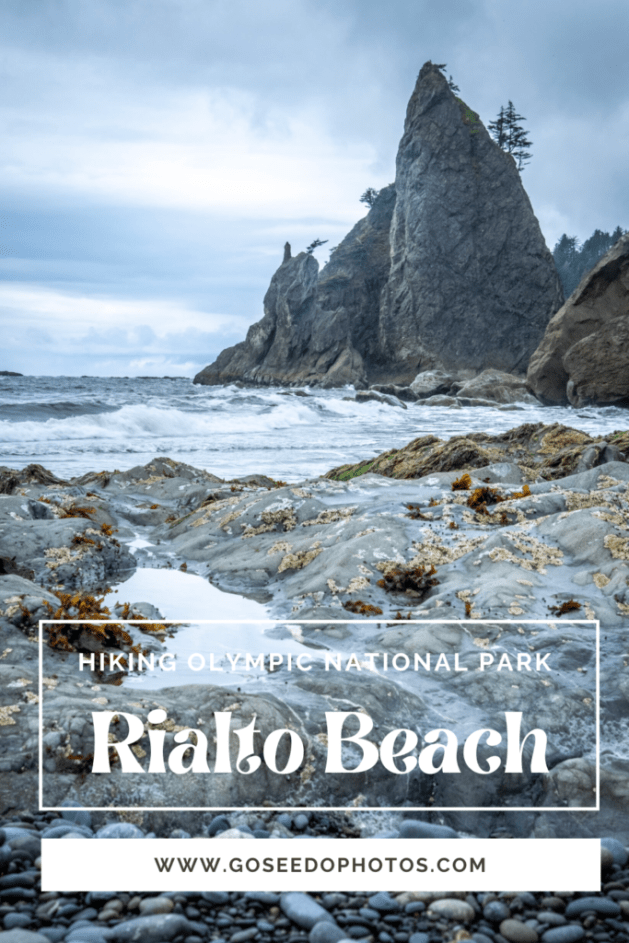After leaving the Lake Crescent Area, we headed to the coast, specifically Rialto Beach. There are many beaches in Olympic National Park so it was hard to choose one to visit. Ruby Beach, one of the most popular beaches on the Olympic Peninsula was closed when we visited due to road construction, so we chose to visit Rialto Beach and do the Hole-in-the-Wall Hike.
When deciding what days to do what in Olympic National Park, we looked at the tide chart. The hike to Hole-in-the-Wall can only be accessed during low tide so we had to plan our visit accordingly. There is a forest service trail that would allow you to see the Hole-in-the-Wall formation during high tide, but you wouldn’t be able to get as close or see the life in the tide pools.
When we got to the beach, it was drizzling a little and it was overcast with a little fog. There were strange rock formations jutting out from the water. It was unlike anything I had ever seen anywhere else. We drove through the town of Forks, Washington to get to the beach and I totally understood why Stephanie Meyer set the Twilight books in this area. It looks like a place where strange sparkly vampires would live!
The trail is a 3.3-mile long out-and-back trail and most of the hike is just an easy walk on the beach, but there are some tricky sections. The scariest part for me (and most of the other women hikers we saw) was the part where you had to cross Ellen’s Creek small stream that dumps into the ocean. The only way to cross it was by walking over a log. One woman told me, I’m sure as an attempt to reassure me, “I’ve been standing here over an hour and I haven’t seen anyone fall in yet.” Luckily, I didn’t ruin her streak, but I did take the chicken’s way out on the way back and scoot across on my butt. Apparently, when the creek is less full, people wade through it instead of the scrambling we had to do.
 From there it wasn’t much further to the rock and the feature known as Hole-in-the-Wall. It is known as Hole-in-the-Wall because over time, the tide eroded the center of the rock and created a hole big enough to walk through. The walk on the rocks was slippery and I was very worried I was going to fall, but seeing all the life in the tide pools was absolutely worth it! We had never explored tide pools before so it was really cool to see! I had no idea starfish came in so many colors! It was crazy because you could be looking at a part of the rock for a while and just keep seeing more.
From there it wasn’t much further to the rock and the feature known as Hole-in-the-Wall. It is known as Hole-in-the-Wall because over time, the tide eroded the center of the rock and created a hole big enough to walk through. The walk on the rocks was slippery and I was very worried I was going to fall, but seeing all the life in the tide pools was absolutely worth it! We had never explored tide pools before so it was really cool to see! I had no idea starfish came in so many colors! It was crazy because you could be looking at a part of the rock for a while and just keep seeing more.
If you are looking for a beach to visit in Olympic National Park, I highly recommend Rialto Beach and the hike to Hole-in-the-Wall. If you are planning to do this hike, waterproof hiking boots with good traction are a must. Walking on the beach, our feet got a little wet, but scrambling over wet rocks would’ve been near impossible without our hiking boots.
Thanks for stopping by! Be sure to check back next week when I share about our time exploring Hurricane Ridge! To read more about this trip check out my Planes, Buses, and Boats Trip Report. To read about some of our previous trips, visit my Trips Page. If you like my photos be sure to “like” my Facebook Page and follow me on Instagram! You can purchase prints on Fine Art America. To see inside my camera bag, check out my updated Gear Page.
Pin This:



























